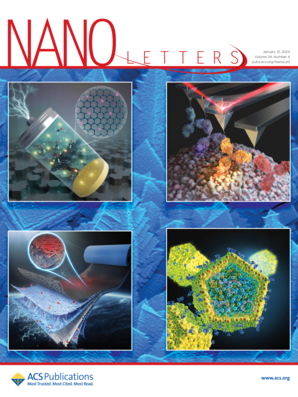Capacity Enhancement in Quasi-Solid-State Lithium–Oxygen Batteries via Self-Constructing Li+ Transport Channels
IF 9.6
1区 材料科学
Q1 CHEMISTRY, MULTIDISCIPLINARY
引用次数: 0
Abstract
Lithium–oxygen batteries (LOBs) attract widespread attention due to their high energy density and safety. The morphology of the solid discharge product bears a close correlation with the battery capacity. In this work, the capacity of LOBs surprisingly increases from 790 mAh g–1 under the liquid electrolyte to 2395 mAh g–1 by using a quasi-solid-state electrolyte (QSSE). The thin film and spherical Li2O2 under the QSSE system construct new Li+ transport channels, which help to extend the solid-phase Li+ transport boundary to the entire electrode to enhance the spatial utilization efficiency of the electrode. Furthermore, a novel mechanism for the growth of Li2O2 is proposed, which is determined by the coupling of the conductivity of Li+ and electrons within the products and the electrode. The result innovatively reveals a new mechanism for the growth of discharge products and a new model of Li+ conduction in LOBs under QSSE systems.

求助全文
约1分钟内获得全文
求助全文
来源期刊

Nano Letters
工程技术-材料科学:综合
CiteScore
16.80
自引率
2.80%
发文量
1182
审稿时长
1.4 months
期刊介绍:
Nano Letters serves as a dynamic platform for promptly disseminating original results in fundamental, applied, and emerging research across all facets of nanoscience and nanotechnology. A pivotal criterion for inclusion within Nano Letters is the convergence of at least two different areas or disciplines, ensuring a rich interdisciplinary scope. The journal is dedicated to fostering exploration in diverse areas, including:
- Experimental and theoretical findings on physical, chemical, and biological phenomena at the nanoscale
- Synthesis, characterization, and processing of organic, inorganic, polymer, and hybrid nanomaterials through physical, chemical, and biological methodologies
- Modeling and simulation of synthetic, assembly, and interaction processes
- Realization of integrated nanostructures and nano-engineered devices exhibiting advanced performance
- Applications of nanoscale materials in living and environmental systems
Nano Letters is committed to advancing and showcasing groundbreaking research that intersects various domains, fostering innovation and collaboration in the ever-evolving field of nanoscience and nanotechnology.
 求助内容:
求助内容: 应助结果提醒方式:
应助结果提醒方式:


